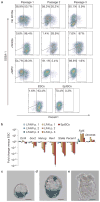Embryonic stem cells require Wnt proteins to prevent differentiation to epiblast stem cells
- PMID: 21841791
- PMCID: PMC4157727
- DOI: 10.1038/ncb2314
Embryonic stem cells require Wnt proteins to prevent differentiation to epiblast stem cells
Abstract
Pluripotent stem cells exist in naive and primed states, epitomized by mouse embryonic stem cells (ESCs) and the developmentally more advanced epiblast stem cells (EpiSCs; ref. 1). In the naive state of ESCs, the genome has an unusual open conformation and possesses a minimum of repressive epigenetic marks. In contrast, EpiSCs have activated the epigenetic machinery that supports differentiation towards the embryonic cell types. The transition from naive to primed pluripotency therefore represents a pivotal event in cellular differentiation. But the signals that control this fundamental differentiation step remain unclear. We show here that paracrine and autocrine Wnt signals are essential self-renewal factors for ESCs, and are required to inhibit their differentiation into EpiSCs. Moreover, we find that Wnt proteins in combination with the cytokine LIF are sufficient to support ESC self-renewal in the absence of any undefined factors, and support the derivation of new ESC lines, including ones from non-permissive mouse strains. Our results not only demonstrate that Wnt signals regulate the naive-to-primed pluripotency transition, but also identify Wnt as an essential and limiting ESC self-renewal factor.
Conflict of interest statement
The authors declare no competing financial interests.
Figures





Comment in
-
Wnt: what's needed to maintain pluripotency?Nat Cell Biol. 2011 Sep 2;13(9):1024-6. doi: 10.1038/ncb2333. Nat Cell Biol. 2011. PMID: 21892143
References
-
- Nichols J, Smith A. Naive and primed pluripotent states. Cell Stem Cell. 2009;4:487–492. - PubMed
-
- Niwa H. Open conformation chromatin and pluripotency. Genes Dev. 2007;21:2671–2676. - PubMed
-
- Brons IG, et al. Derivation of pluripotent epiblast stem cells from mammalian embryos. Nature. 2007;448:191–195. - PubMed
-
- Tesar PJ, et al. New cell lines from mouse epiblast share defining features with human embryonic stem cells. Nature. 2007;448:196–199. - PubMed
Publication types
MeSH terms
Substances
Grants and funding
LinkOut - more resources
Full Text Sources
Other Literature Sources
Medical
Molecular Biology Databases

